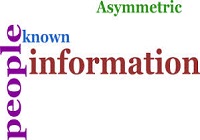In economics, information asymmetry or asymmetrical information occurs when one party to a transaction has more or better information than the other party. Asymmetric information is a cause of market failure in many different areas.
One of most commonly used example is the market for used cars. A new car may be worth a high amount but if the buyer of that car wishes to sell it almost immediately after purchase its value drops sharply. This is because the buyers are cautious that something may be wrong with the car even though the seller of the car just decided they didn’t want it anymore. Here the seller of the car has more information than the buyer.
Other examples of situations in which the seller usually has better information than the buyer are mortgage brokers, stockbrokers, real estate agents, and life insurance transactions.
Examples of situations where the buyer usually has better information than the seller include real estate sales, sales of old art pieces without prior professional computation of their value, or health insurance customers of various risk levels.
There are two basic models that describe asymmetric information and they are as follows:-
(1) Moral hazard
(2) Adverse selection
Adverse Selection
When buyers and sellers have access to different information, traders with better private information about some aspect of product quality will selectively participate in trades which benefits them the most at the expense of the other trader.
A classic example is Akerlof’s market for lemons.
“The Market for Lemons: Quality Uncertainty and the Market Mechanism” is a 1970 paper by the economist George Akerlof which studies how the quality of goods traded in a market place can deteriorate in the presence of asymmetric information between buyers and sellers, leaving only “lemons” behind.
A lemon is an American slang term for a car that is found to be defective only after it has been bought.
Let us say buyers can’t distinguish between a good quality car from a “lemon”. Then they will be willing to pay a fixed price for a car that averages the value of a good one and “lemon” together. But sellers know whether they hold a good one or a lemon. Given the fixed price which buyers are willing to buy at, sellers are only willing to sell when they hold “lemons” and leave the market when they hold good quality cars since its price will be high than average price.
Hence, the uninformed buyer’s price creates an adverse selection problem which drives the quality cars from the market. Adverse selection is the market mechanism that leads to a market collapse.
This is the problem created by asymmetric information before the transaction occurs.
In the case of loans market, lenders cannot price discriminate (i.e. vary interest rates) between good and bad borrowers in loan contracts, because the riskiness of projects cannot be observed. As the interest rates increase, relatively good borrowers leave the market, increasing the probability of default due to bad credit risk borrowers remain.
Another example of adverse selection is when people who are at high risk are more likely to buy insurance such as in case of health insurance, because the insurance company cannot effectively separate the good and bad risk people, usually due to lack of information about the particular individual’s risk. An example is in offering health insurance, the types of customers most likely to apply are those who are most prone to accidents.
Another example is when in a stock market a buyer has better information than a seller, or vice versa, the trade may occur at a lower price than otherwise. When there is adverse selection, people who know that there is a higher probability of getting a profit from some trade they will do it and if they are aware that there is a lower probability of earning profit or it is too expensive to trade they will hold off the trading. So, the ‘better informed’ investors will obtain a trading advantage. A classic example of this would be
insider trading.
SOLUTIONS
- Signalling the potential buyers that you have high quality product such as by giving warranties and guarantees
- Judging quality of a product by price offered
- In insurance markets one solutions to pool risks so as to diversify the risks of defaults
- Maintaining the reputation by selling high quality products and providing good after sale services
- Standardization like we know that McDonalds will use the same type of ingredients in its food item
- Screening such as when an uninformed party take actions to induce the informed party to reveal private information such as by giving a test drive in case of used cars market or by publishing yearly budget reports in case of capital market companies
MORAL HAZARD
The individuals generally are not liable to bear their consequences of their actions is the central problems of the incentives. For example, your stockbroker who maintains your portfolio of shares may take huge risks with your shares. But, since he is registered on an index and is backed by government you do not have the incentive to check periodically on what he does.
When there is misalignment of incentives, we can say that there is a problem of moral hazard. The term had originated in the insurance industry since the individuals who had purchased insurance had an incentive to avoid insured against event. For example, an individual who has fire insurance has less of an incentive to avoid a fire. The insured person would not be inclined to put a sprinkler system or a fire alarm system because he may not find it worth.
This is the problem created by asymmetric information after the transaction occurs
SOLUTIONS
- Contract solutions which obligate the buyers and sellers to follow certain conditions
- Incentive to maintain reputation in the market will lead to production of high quality products
- Specifying the pre-conditions or precautions to be maintained by an individual like in health insurance for yearly health checkups.
Click here for government certification in Accounting, Banking & Finance





3 Comments. Leave new
Nice article!
Good one…
Informative!